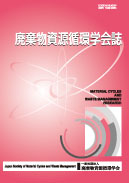Volume 26, Issue 2
Displaying 1-13 of 13 articles from this issue
- |<
- <
- 1
- >
- >|
Preface
-
2015Volume 26Issue 2 Pages 95-96
Published: March 31, 2015
Released on J-STAGE: June 14, 2021
Download PDF (196K)
Special Issues : Recent Trends of Waste to Energy Plants
-
2015Volume 26Issue 2 Pages 97-104
Published: March 31, 2015
Released on J-STAGE: June 14, 2021
Download PDF (869K) -
2015Volume 26Issue 2 Pages 105-113
Published: March 31, 2015
Released on J-STAGE: June 14, 2021
Download PDF (2949K) -
2015Volume 26Issue 2 Pages 114-119
Published: March 31, 2015
Released on J-STAGE: June 14, 2021
Download PDF (854K) -
2015Volume 26Issue 2 Pages 120-129
Published: March 31, 2015
Released on J-STAGE: June 14, 2021
Download PDF (1517K) -
2015Volume 26Issue 2 Pages 130-135
Published: March 31, 2015
Released on J-STAGE: June 14, 2021
Download PDF (578K) -
2015Volume 26Issue 2 Pages 136-143
Published: March 31, 2015
Released on J-STAGE: June 14, 2021
Download PDF (821K) -
2015Volume 26Issue 2 Pages 144-151
Published: March 31, 2015
Released on J-STAGE: June 14, 2021
Download PDF (1053K)
Solid Waste Archives Series / Records of “Garbage War”
-
2015Volume 26Issue 2 Pages 152
Published: March 31, 2015
Released on J-STAGE: June 14, 2021
Download PDF (145K) -
2015Volume 26Issue 2 Pages 153-159
Published: March 31, 2015
Released on J-STAGE: June 14, 2021
Download PDF (642K)
Activity Report from the Regional Chapter
-
2015Volume 26Issue 2 Pages 160-161
Published: March 31, 2015
Released on J-STAGE: June 14, 2021
Download PDF (346K) -
2015Volume 26Issue 2 Pages 162-164
Published: March 31, 2015
Released on J-STAGE: June 14, 2021
Download PDF (495K)
Book Review
-
2015Volume 26Issue 2 Pages 165
Published: March 31, 2015
Released on J-STAGE: June 14, 2021
Download PDF (173K)
- |<
- <
- 1
- >
- >|
